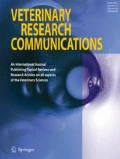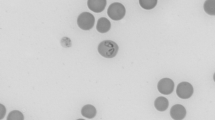Abstract
The prevalence of Babesia equi in two climatic regions of Minas Gerais state was determined using the indirect fluorescent antibody test (IFAT) with blood samples obtained from horses in two slaughterhouses. Of 399 samples, 241 (60.4%) showed a positive reaction. Anti-B. equi antibody was detected in every county studied, the prevalence being 59.7% for horses in the area where the temperature rises above 18°C in winter and 61.4% in the area where it remains below 18°C, indicating that climatic variation has no substantial effect on the prevalence of the infection in Brazil. Blood samples collected from all 95 horses on a ranch in the state of Minas Gerais, Brazil, on which clinical babesiosis had never been reported, were subjected to the IFAT. Anti-B. equi antibodies were detected in horses of all ages, but with a significantly lower prevalence in animals less than 6 months old.
Similar content being viewed by others
REFERENCES
Ali, S., Sugimoto, C. and Onuma, M., 1996. Equine piroplasmosis. Journal of Equine Sciences, 7, 67–77
Amerault, T.E., Frerichs, W.M. and Stiller, D., 1979. Comparative serologic study of equine piroplasmosis with the card test and complement-fixation tests. American Journal of Veterinary Research, 40, 529–531
Antunes, F.Z., 1986. Caracterização climãtica do estado de Minas Gerais. Informe Agropecuãria, 12, 9–13
Borges, L.M.F. and Leite, R.C., 1998. Ixodological populations of the ears of equines in Minas Gerais and Bahia, Brazil. Brazilian Journal of Veterinary and Animal Sciences, 50, 87–89
Centro Panamericano do Zoonosis (Cepanzo), 1973. Procedimentos Para Estudios de Prevalencia de Enfermidades Cronicas en el Ganado, (Ramos Mejia, Buenos Aires)
Correa, B., Urcelay, V.S., Rudolph, R.W. and Montes, O.G., 1977. Piroplasmosis en caballos de carrera: estudio serológico en hipodromos de Santiago. Boletin Chileno Parasitologia, 32, 21–22
Cunha, C.W., 1993. Babesiose equina: Padronização da reação de imunofluorescência para sorodiagnóstico e levantamento epidemiológico em equinos puro sangue inglês, (Thesis, Universidade Federal de Pelotas, Pelotas)
Donnelly, S. and Phipps, L.P., 1982. Evidence of maternal antibodies to Babesia equi and Babesia caballi in foals of seropositive mares. Equine Veterinary Journal, 14, 126–128
Donnelly, S., Joyner, L.P., Graham-Jones, O. and Ellis, C.P., 1980. A comparison of the complement fixation and immuno£uorescent antibody tests in a survey of the prevalence of Babesia equi and Babesia caballi in horses in the Sultanate of Oman. Tropical Animal Health and Production, 12, 50–60
Durrieu, E. and Cifocelli, A.V., 1972. Piroplasmosis equine. Gazetta Veterinaria, 568–581
Guimarães, A.M., Lima, J.D., Ribeiro, M.F.B., Camargos, E. R.S. and Bozzi, I.A., 1998a. Ultrastructure of sporogony in Babesia equi in salivary glands of adult female Boophilus microplus ticks. Parasitology Research, 84, 69–74
Guimarães, A.M., Lima, J. D. and Ribeiro, M.F.B., 1998b. Sporogony and experimental transmission of Babesia equi by Boophilus microplus. Parasitology Research, 84, 323–327
Holbrook, A.A., Frerichs, W.M. and Allen, P.C., 1972. Laboratory diagnosis of equine piroplasmosis. In: Proceedings of the 3rd International Conference Equine Infection Disease, Paris, 467–475
IBGE, 1998. Censo Agropecuário de Minas Gerais, (Instituto Brasileiro de Geografia e Estatística, Rio de Janeiro)
IICA, 1987. Tecnicas para el Diagnóstico de Babesiosis y Anaplasmosis Bovine, (Instituto Interamericano de Cooperação para la Agricultura, San José, Costa Rica)
Ribeiro, M..B. and Lima, J.D., 1989. Diagno¨ stico sorolo¨ gico de babesiose equina por Babesia equi em Minas Gerais. Semina¨ rio Brasileiro de Parasitologia Veterina¨ ria, IV, Bagé, 111
Schein, E., 1988. Equine babesiosis. In: M. Ristic (ed.), Babesiosis of Domestic Animals and Man, (CRC Press, Boca Raton, FL), 197–208
Taylor, W.M., Bryant, J.E., Anderson, J.B. and Willers, K.H., 1969. Equine piroplasmosis in the United States-a review. Journal of the American Veterinary Medicine Association, 155, 915–919
Tenter, A.M. and Friedhoff, K.T., 1986. Serodiagnosis of experimental and natural Babesia equi and Babesia caballi infections.Veterinary Parasitology, 20, 49–61
Tenter, A.M., Otte, M.J., Gonzales, C.A. and Abuabara, Y., 1988. Prevalence of piroplasmosis in equine in the Colombian Province of Cordoba. Tropical Animal Health and Production, 20, 93–98
Urcelay, S., Correa, J. and Rudolph, W., 1973. Piroplasmosis en caballos de carrera: estudio serologico en criaderos de la Provincia de Santiago. Boletin Chileno Parasitologia, 28, 6–9
Author information
Authors and Affiliations
Rights and permissions
About this article
Cite this article
Ribeiro, M., Costa, J. & Guimara~es, A. Epidemiological Aspects of Babesia equi in Horses in Minas Gerais, Brazil. Vet Res Commun 23, 385–390 (1999). https://doi.org/10.1023/A:1006389725759
Issue Date:
DOI: https://doi.org/10.1023/A:1006389725759




